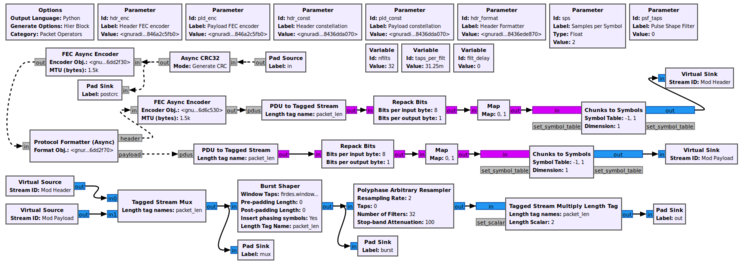Protocol Formatter (Async): Difference between revisions
(Created page with "Category:Block Docs Category:Stub Docs This is the template for the "Page-per-block Docs". This first section should describe what the block...") |
(add example flowgraph) |
||
| (One intermediate revision by one other user not shown) | |||
| Line 1: | Line 1: | ||
[[Category:Block Docs]] | [[Category:Block Docs]] | ||
Uses a header format object to append a header onto a PDU. | |||
This | |||
This block takes in PDUs and creates a header, generally for MAC-level processing. Each received PDU is assumed to be its own frame, so any fragmentation would be done upstream in or before the flowgraph. | |||
The header that is created and transmitted out of the 'header' message port as a PDU. The header is based entirely on the object, which is an object derived from the header_format_base class. All of these packet header format objects operate the same: they take in the payload data as well as possible extra metadata info about the PDU; the format object then returns the output PDU as a PMT argument along with any changes to the metadata info PMT. | |||
For different packet header formatting needs, we can define new classes that inherit from the header_format_base block and which overload the header_format_base::format function. | |||
== Parameters == | == Parameters == | ||
; | ; Format Obj. | ||
: | : The format object to use when reading the header. This block uses a format object derived from a header_format_base class. | ||
== Example Flowgraph == | |||
This flowgraph can be found at [https://github.com/gnuradio/gnuradio/blob/master/gr-digital/examples/packet/packet_tx.grc] | |||
[[File:Packet_tx_fg.png|746px]] | |||
== Source Files == | == Source Files == | ||
; C++ files | ; C++ files | ||
: [https://github.com/gnuradio/gnuradio | : [https://github.com/gnuradio/gnuradio/blob/master/gr-digital/lib/protocol_formatter_async_impl.cc] | ||
; Header files | ; Header files | ||
: [https://github.com/gnuradio/gnuradio | : [https://github.com/gnuradio/gnuradio/blob/master/gr-digital/lib/protocol_formatter_async_impl.h] | ||
; Public header files | ; Public header files | ||
: [https://github.com/gnuradio/gnuradio | : [https://github.com/gnuradio/gnuradio/blob/master/gr-digital/include/gnuradio/digital/protocol_formatter_async.h] | ||
; Block definition | ; Block definition | ||
: [https://github.com/gnuradio/gnuradio | : [https://github.com/gnuradio/gnuradio/blob/master/gr-digital/grc/digital_protocol_formatter_async.block.yml] | ||
Latest revision as of 14:23, 6 April 2021
Uses a header format object to append a header onto a PDU.
This block takes in PDUs and creates a header, generally for MAC-level processing. Each received PDU is assumed to be its own frame, so any fragmentation would be done upstream in or before the flowgraph.
The header that is created and transmitted out of the 'header' message port as a PDU. The header is based entirely on the object, which is an object derived from the header_format_base class. All of these packet header format objects operate the same: they take in the payload data as well as possible extra metadata info about the PDU; the format object then returns the output PDU as a PMT argument along with any changes to the metadata info PMT.
For different packet header formatting needs, we can define new classes that inherit from the header_format_base block and which overload the header_format_base::format function.
Parameters
- Format Obj.
- The format object to use when reading the header. This block uses a format object derived from a header_format_base class.
Example Flowgraph
This flowgraph can be found at [1]
Source Files
- C++ files
- [2]
- Header files
- [3]
- Public header files
- [4]
- Block definition
- [5]
